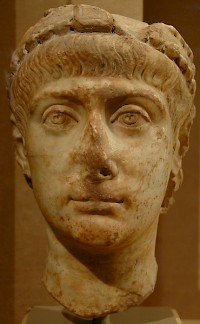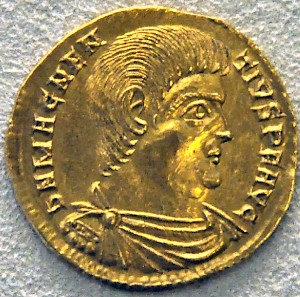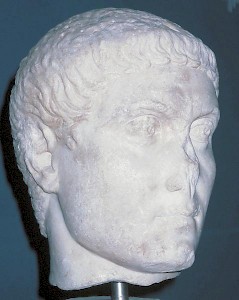Servatius of Tongeren
Servatius (†384): bishop of Tongeren, one of the first Christian leaders in the Low Countries.

Servatius was the first bishop of Tongeren, the capital of the Tungri in the east of what is now called Belgium. In the fourth century, it belonged to a province of the Roman empire called Germania Secunda. In those days, Christianity was quickly gaining ground. In 311, the emperor Galerius had put an end to the great persecutions, and another emperor, Constantine I the Great, actually favored the Church. For example, he gave juridical powers to the leader of a Christian community in a town, the bishop. Moreover, he gave fiscal privileges to the funds of Christian charity, for which the bishop was responsible. From now on, a wealthy man could show that he cared for his community by becoming bishop, and many members of the Roman elite converted.
The first known bishop in the Low Countries is Maternus of Cologne, who attended the Council of Arles in 314. (During this meeting, the Church gave up its pacifism.) Servatius belonged to the next generation. According to a medieval legend, he was not born in Tongeren, but in Armenia. This piece of information is a bit problematic, because a bishop needed to possess land near the town where he resided. It was the only way to manage the capital needed for charity. We can of course assume that Servatius sold all his worldly possessions before traveling to the far west, where he invested his money in land again, but this is a bit farfetched. On the other hand, why would a medieval hagiographer risk his credibility by inventing an Armenian descent?
However this me be, Servatius must have been a rich man, because he was able to travel throughout the Roman empire. In 343, he was present at the Council of Serdica (modern Sofia), where a man named "Sarbatios" signed a decree against the followers of the theologian Arius of Alexandria, a man of immense learning who had spoken about Christ in terms that appeared to debase the divine nature of the Savior.

In this debate, the western and eastern halves of the empire took different positions. The eastern emperor Constantius II agreed with Arius that Christ was neither co-eternal nor of one substance with God the Father, but had been created as an instrument for the salvation of mankind. Christ was, therefore, subordinate to the Father, and his nature was not divine but human. The western emperor Constans, a brother of Constantius, said that the Son and the Father were of the same substance - in other words, that Christ was truly God. In this debate, Servatius, who had traveled 3,000 kilometers to be present, represented the views of his emperor. Because the eastern bishops shared the opinions of their ruler, the Council of Serdica was a failure.

Seven years later, the western emperor Constans fell victim to a plot. During a dinner party, a group of courtiers proclaimed Magnentius emperor, and Constans was murdered (350). The new emperor sent "Sarbatios" as an envoy to Constantius. The bishop of Tongeren had to explain that Constans had behaved like a tyrant and had suppressed the population with high taxes. The aim of Servatius' mission was, of course, to obtain recognition of his emperor from the ruler of the east. He met Constantius in Edessa in Syria (after a trip of 5,000 kilometers), but was unable to appease his host. The result was an extremely bloody civil war, which lasted two years and resulted in the death of Magnentius (351-353).
We do not know why Magnentius sent Servatius as an envoy, but it suggests that the bishop belonged to the inner circle of the usurper. Since he seems to have had his base of power in northern Gaul, it is possible that both men were friends.

In 359, the emperor Constantius, now sole ruler of the Roman empire, decided that the time had come to end the religious debate on the nature of Christ. A new Council was summoned at Rimini, where the emperor wanted the bishops to agree on a compromise. However, the opposition was strong. One of the most eloquent speakers against the emperor's proposal was Servatius of Tongeren.
This time, our source, Sulpicius Severus, calls him "Servatius", not "Sarbatios". The difference between the two versions of the name can be ignored: our sources for the Council of Serdica and the failed embassy are written in Greek, and the Greeks wrote the sound /v/ with a beta.

This is all we know about Servatius from official, ecclesiastical texts. However, he was also remembered in his diocese as the builder of two churches: one in Tongeren, and one in Maastricht. As far as Tongeren is concerned, the tradition has been confirmed by excavations. Under the medieval basilica of Our Lady, the remains of a pretty large fourth-century church have been identified. Excavation of the basilica of Our Lady Star of the Sea in Maastricht, one of the most beloved sacred places in the Low Countries, has not been possible, but it is likely that this church was founded by Servatius as well. It was built on the site of an older, pagan sanctuary and must have been a small chapel - not to be compared with the church of Tongeren - because fourth-century Maastricht was a small fortress.
Three years after the Council of Constantinople, where the teachings of Arian were finally condemned, Servatius probably died in Maastricht (384). From now on, Maastricht was to be the seat of a bishop. It was not very usual to transfer the capital of a diocese, and we do not know why this happened.
An explanation has been offered by bishop Gregory of Tours, who wrote, two centuries after the death of Servatius, that a bishop of Tongeren named Aravatius had been ordered by Saint Peter to leave Tongeren and settle in Maastricht. Tongeren, Peter said, was to be destroyed by the Huns because of the sins of its inhabitants.note When Aravatius had arrived at Maastricht, he fell ill of a mild fever, died, and was buried beside the public highroad. This story has been accepted by several scholars, who usually interpret the "sins" as a reference to a quarrel between the shepherd and his Tungrian flock. An additional argument is that the tomb of Servatius is still venerated on a place that was once near the road to Tongeren.
However, this theory must be rejected. In the first place, "Aravatius" is simply not the same name as "Servatius" or "Sarbatios". In the second place, the invasion of the Huns took place in 451. Finally, Gregory finishes his story with the remark that later, the holy body was moved elsewhere. If we want to accept Gregory's story, we must assume that he made no less than three errors, and although the saintly bishop of Tours is quite capable of mistakes, this is a bit too much. The idea that Servatius moved the bishop's seat to Maastricht after a quarrel is insupportable.
So we are left with a bishop of Tongeren who played a role of some importance in the Roman empire and built a church in his hometown. Probably, he also built the chapel of Maastricht. There is no reason to doubt that he lies buried in the basilica of Saint Servatius at Maastricht, which was founded in c.560.
The holy day of the first Christian leader of Belgium and the Netherlands is 13 May. His three basilicas - Our Lady in Tongeren, Our Lady Star of the Sea in Maastricht, and Saint Servatius in Maastricht - are among the most beautiful medieval monuments in the Low Countries.